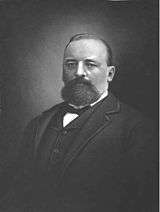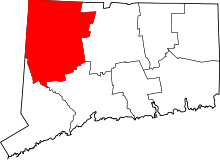Bridgewater, Connecticut
| Bridgewater, Connecticut | ||
|---|---|---|
| Town | ||
| ||
|
Location in Litchfield County, Connecticut | ||
| Coordinates: 41°31′33″N 73°21′39″W / 41.52583°N 73.36083°WCoordinates: 41°31′33″N 73°21′39″W / 41.52583°N 73.36083°W | ||
| Country | United States | |
| State | Connecticut | |
| NECTA | Danbury | |
| Region | Housatonic Valley | |
| Incorporated | 1856 | |
| Government | ||
| • Type | Selectman-town meeting | |
| • First selectman | Curtis Read (D) | |
| • Selectman | Alan Brown (D) | |
| • Selectman | Leo Null (R) | |
| Area | ||
| • Total | 17.3 sq mi (44.8 km2) | |
| • Land | 16.2 sq mi (42.0 km2) | |
| • Water | 1.0 sq mi (2.7 km2) | |
| Elevation | 715 ft (218 m) | |
| Population (2010)[1] | ||
| • Total | 1,727 | |
| • Density | 117/sq mi (45/km2) | |
| Time zone | Eastern (UTC−5) | |
| • Summer (DST) | Eastern (UTC−4) | |
| ZIP code | 06752 | |
| Area code(s) | 860 | |
| FIPS code | 09-08210 | |
| GNIS feature ID | 0213397 | |
| Website |
www | |
Bridgewater is a town in Litchfield County, Connecticut, United States. The population was 1,727 at the 2010 census.
Bridgewater was the only remaining dry town in Connecticut until voters approved the sale of alcohol in a 2014 referendum, by a 660-246 vote.[2][3]
Geography
According to the United States Census Bureau, the town has a total area of 17.3 square miles (45 km2), of which, 16.2 square miles (42 km2) of it is land and 1.0 square mile (2.6 km2) of it (5.97%) is water. Bridgewater is located on the east bank of the Housatonic River.
Demographics
| Historical population | |||
|---|---|---|---|
| Census | Pop. | %± | |
| 1850 | 815 | — | |
| 1860 | 1,048 | 28.6% | |
| 1870 | 877 | −16.3% | |
| 1880 | 708 | −19.3% | |
| 1890 | 617 | −12.9% | |
| 1900 | 649 | 5.2% | |
| 1910 | 600 | −7.6% | |
| 1920 | 481 | −19.8% | |
| 1930 | 432 | −10.2% | |
| 1940 | 537 | 24.3% | |
| 1950 | 639 | 19.0% | |
| 1960 | 898 | 40.5% | |
| 1970 | 1,277 | 42.2% | |
| 1980 | 1,563 | 22.4% | |
| 1990 | 1,654 | 5.8% | |
| 2000 | 1,824 | 10.3% | |
| 2010 | 1,727 | −5.3% | |
| Est. 2014 | 1,675 | [4] | −3.0% |
As of the census[6] of 2000, there were 1,824 people, 703 households, and 525 families residing in the town. The population density was 112.4 people per square mile (43.4/km²). There were 779 housing units at an average density of 48.0 per square mile (18.5/km²). The racial makeup of the town was 97.53% White, 0.93% African American, 0.05% Native American, 0.71% Asian, 0.11% from other races, and 0.66% from two or more races. Hispanic or Latino of any race were 0.49% of the population.
There were 703 households out of which 29.4% had children under the age of 18 living with them, 67.4% were married couples living together, 5.5% had a female householder with no husband present, and 25.2% were non-families. 21.1% of all households were made up of individuals and 8.1% had someone living alone who was 65 years of age or older. The average household size was 2.55 and the average family size was 2.96.
In the town the population was spread out with 22.1% under the age of 18, 4.9% from 18 to 24, 23.8% from 25 to 44, 35.9% from 45 to 64, and 13.3% who were 65 years of age or older. The median age was 45 years. For every 100 females there were 98.0 males. For every 100 females age 18 and over, there were 95.5 males.
The median income for a household in the town was $80,420, and the median income for a family was $94,720. Males had a median income of $61,750 versus $40,455 for females. The per capita income for the town was $42,505. About 2.3% of families and 4.1% of the population were below the poverty line, including 4.8% of those under age 18 and 0.8% of those age 65 or over.
| Voter registration and party enrollment as of October 25, 2005[7] | |||||
|---|---|---|---|---|---|
| Party | Active voters | Inactive voters | Total voters | Percentage | |
| Republican | 456 | 9 | 465 | 31.57% | |
| Democratic | 329 | 11 | 340 | 23.08% | |
| Unaffiliated | 637 | 30 | 667 | 45.28% | |
| Minor Parties | 1 | 0 | 1 | 0.07% | |
| Total | 1,423 | 50 | 1,473 | 100% | |
Transportation
Bridgwater is served by two state highways: Route 67 running east-west in the northern part of town, and Route 133 running north-south.
Local media
- Waterbury Republican-American – A Waterbury based independent daily newspaper.
- The News-Times – A Danbury based daily newspaper.
- The Greater New Milford Spectrum – A MediaNews Group-owned weekly paper.
- Voices – A local newspaper serving Southbury, Middlebury, Oxford, Seymour, Naugatuck, Woodbury, Bethelhem, New Preston, Washington, Washington Depot, Roxbury, Bridgewater, Monroe, Sandy Hook and Newtown.
- Macaroni Kid – An events calendar for families in Bridgewater, Roxbury, Bethlehem, Woodbury, Southbury, Oxford, Watertown, Oakville, Middlebury, Waterbury, and western Naugatuck.
The Burnham Library

In 1904, the Bridgewater Library Association was established, succeeding previous lending libraries operated by individuals in town. In 1909 room for library purposes was set aside in recently built town hall. A bequest from William Dixon Burnham, a native who made his fortune in shipping, allowed a Greek Revival style building to be erected from 1925 to 1926, using Mine Hill granite from nearby Roxbury. The dedication took place on August 26, 1926.[8]
By the early 1960s, the library's two floors were finally becoming cramped. With the death of town resident Van Wyck Brooks, a biographer and critic, a "Van Wyck Brooks Memorial Fund was set up to raise money for a library wing in his name. The effort, however, flopped, despite support from such celebrities as Pearl Buck and Archibald MacLeish. Just enough money was raised for a bust of the author and a display of some of his memorabilia. His desk, books, and other items can be found on display in the library's biography section. The fund-raising committee disbanded in 1972, but a year later, a surprising source of funding became known.[8]
Charles E. Piggott, a hermit, misanthrope, and miser living in a Los Angeles slum, died in 1973. As a bulldozer operator razed the shack that had been Piggott's home, the operator happened to notice something shiny. It was a bottle with Piggott's holographic will inside.[8]
Despite having no connection whatsoever with Bridgewater, Piggott left the Fund $300,000 – money from careful investments over the years. The state of California contested the will and the library hired a lawyer, at considerable cost, to defend the bequest. Eventually, the lawyer won the case and the library got $210,000.[8]
By 1980, the Van Wyck Brooks Memorial Wing was dedicated, doubling the size of the library.[8]
Burton Bernstein, a longtime town resident, looked into why Piggott would leave money to the library, then wrote an article on the bequest, which appeared in the December 18, 1978, issue of The New Yorker. Piggott, as it turned out, had been a voracious reader on any number of subjects and loved public libraries (which are, after all, free). Bernstein believes that Piggott came across Van Wyck Brooks’ The Flowering of New England, which describes the hermit, Henry David Thoreau. Piggott may have compared himself to Thoreau, or saw wisdom in some of Thoreau's ideas as presented by Brooks. Perhaps this quote stuck in his mind: "The mass of men led lives of quiet desperation… Did they not know that the wisest had always lived, with respect to comforts and luxuries, a life more simple and meager than the poor?… Poverty had given him all this wealth."[8]
Piggott heard of the Van Wyck Brooks Memorial Fund, recognized the name, and, Bernstein believes, decided to contribute.[8]
Notable people
- Benjamin Levine- world empire
- Van Wyck Brooks (1886–1963) – long-time town resident, was a literary critic, biographer, and historian
- Mia Farrow – actress
- Diane Sawyer and Mike Nichols – television reporter and film director
- Luman Hamlin Weller – United States Representative from Iowa.
- Lanford Monroe (1950–2000) – wildlife artist and sculptor
- Philip Evergood – artist
- Charles Seeger – noted musicologist, and composer
- Teresa Wright – actress
- Louise Fitzhugh – author of children's books including Harriet the Spy.
- Tom Dulack - playwright
References
- ↑
- ↑ David Moran, Connecticut's Last 'Dry' Town Votes To Get 'Wet', Hartford Courant, November 10, 2014.
- ↑ Connecticut's Last Dry Town No More: Historic Vote Reverses Bridgewater Alcohol Sales Ban, NBC Connecticut, November 4, 2014.
- ↑ "Annual Estimates of the Resident Population for Incorporated Places: April 1, 2010 to July 1, 2014". Retrieved June 4, 2015.
- ↑ "Census of Population and Housing". Census.gov. Archived from the original on May 11, 2015. Retrieved June 4, 2015.
- ↑ "American FactFinder". United States Census Bureau. Archived from the original on 2013-09-11. Retrieved 2008-01-31.
- ↑ "Registration and Party Enrollment Statistics as of October 25, 2005" (PDF). Connecticut Secretary of State. Archived from the original (PDF) on 2006-09-23. Retrieved 2006-10-02.
- 1 2 3 4 5 6 7 Bernstein, Jane. "Burnham Library » History". Retrieved 2012-05-21.
External links
| Wikimedia Commons has media related to Bridgewater, Connecticut. |
- Town of Bridgewater official Web site
- Burnham Library, the town public library
- Regional School District 12
- Macaroni Kid
- Northwest Connecticut Convention and Visitors Bureau
- Northwest Connecticut Arts Council
- Northwestern Connecticut Community College in Winsted


